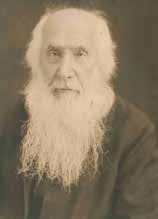The Diocese of Duluth has announced the initial steps towards the beatification of Monsignor Joseph Buh, a pioneering missionary whose remarkable life and enduring legacy continue to inspire generations. Born on March 17, 1833, in present- day Slovenia, Msgr. Buh dedicated his life to serving Native American communities and immigrant populations in Minnesota, leaving a deep-seated mark on the region’s spiritual and cultural landscape.
According the history book “Ely, Since 1888,” Msgr. Buh was the Catholic priest in Ely from November of 1900 until his death in 1922.
Msgr. Buh’s missionary journey to the United States began in 1864. His extraordinary ministry was characterized by a profound commitment to the spiritual and physical well-being of those he served. He was instrumental in establishing 57 parishes and played a pivotal role as the vicar general of the Diocese of Duluth. His tireless efforts and deep faith earned him the admiration and respect of his contemporaries and laid a strong foundation for future generations.
Bishop Timothy McNicholas of Duluth, who spoke at Msgr. Buh’s funeral in 1922, described him as “a saintly priest whose life was a benediction and whose memory will be an inspiration for future generations.” This sentiment captures the essence of Msgr. Buh’s life—a life devoted to the service of God and humanity.
Fr. Richard Kunst, who is overseeing the initial steps of the process, underscores the significance of his sanctity and missionary zeal. “It was very abundantly clear, at least in reading the biography, that his spirituality was impressive,” Fr. Kunst said. “He embodied a total emptying of self, especially for the Native Americans and immigrants among whom he ministered.”
Almost 16 years ago, in September 2008, Fr. Kunst wrote a column in The Northern Cross about the canonization process and how an individual becomes a saint. “The whole idea of canonization should feel closer to home for us as a diocese, and it certainly seems more real to me personally, since we are in the beginning stages of discerning a ‘cause’ for one of our very own in Msgr. Joseph Buh,” he reflected.
Msgr. Joseph Buh: A Multilingual Pioneer Fostering Community and Faith Msgr. Buh’s life is a testament to humility, zeal, and unwavering faith. His dedication to the sacraments of the Catholic Church was profound, but equally profound was his work within the communities he served. In the 1880s, the iron ore mining boom brought a flood of new immigrants to the area. Buh’s working knowledge of six languages made him indispensable to these newcomers.
In 1891, he established what would become the first Slovenian newspaper in the United States. From 1892 to 1898, he served as the editor and publisher of Amerikanski Slovenec. Initially, he managed everything for the paper, from creating layout copy to overseeing typesetting and printing. He put in long hours to ensure the newspaper’s success, driven by his goal to “better the Slovenians in America.”
His efforts in founding the American Slovene Catholic Union and his work among the Native American tribes underscore his commitment to fostering communities and supporting those in need.
Miracles of Faith: The Enduring Legacy of Msgr. Joseph Buh’s Intercession In 1971, two Benedictine sisters published a comprehensive 368-page biography of the missionary titled Masinaigans, meaning “little book.” This nickname, given by the Chippewa, referred to Msgr. Buh’s constant companion, his ordo or diary. They also called him Meshidong, meaning “Long Beard.”
According to Masinaigans, numerous instances occurred after Msgr. Buh’s death where people found relief from illnesses, recovered from injuries, and experienced increased faith through prayer to him. The authors write, “If in life he did so much, why should he cease after death if death be but the transition to a perfect life? The holiness of his life bears testimony to the holiness of his present state in heavenly Jerusalem.” (pg. 259).
To illustrate this point, the authors recount the story of Sister Jean Castonguay, a member of their community, who experienced what she called a miraculous cure through the intercession of Msgr. Buh. Here is Sister Jean’s account in her own words: “It was 1947 when I noticed a lump on my breast. Dr. Strobel diagnosed it as cancer. I only later learned that they gave no hope for me at the time of the surgery, just before Christmas that year. When I survived the surgery, they gave me only 2-3 days; then the time limit was moved, but then I might not see Christmas. Before surgery, I prayed – not for a cure, but that God’s will be done. But I left it in Buh’s hands. However, I had taken that old Buh shirt and made a cap from the sleeve; I wore it on my head during this time. Following the surgery and my earliest survival days, I had two series of radiation treatments of 18 each. This is 1970. I have seen many Christmases since the surgery 23 years ago. There has been no recurrence of the cancer. I am in good health today.”
Understanding the Canonization Process Fr. Kunst emphasizes the rigorous nature of the canonization process, which involves discerning that an individual lived a life of heroic virtue. “It is important to note that the pope does not make saints. God does, and the saints themselves do,” he stated. “The church is simply making a statement that we can be certain that this person, by how they lived their life and their faith, is now with God in heaven.”
The process begins with a period of discernment. If it appears there is reason to start, the bishop will petition the Holy See for permission. If there is no objection, the “nihil obstat” (nothing stands in the way) is granted, and the individual gets the title “Servant of God.” This is followed by a thorough investigation of the person’s life and writings to ensure they held orthodox theological views.
Given that Msgr. Buh died in 1922, there are no living witnesses who knew him personally, but there are many who knew people who knew Buh. “In my own parish, there is a person whose grandparents were married by Buh and whose uncles were baptized by him,” Fr. Kunst noted. These connections help keep his memory and influence alive.
Recently, Msgr. Buh’s remains were exhumed for eventual entombment at the Cathedral of Our Lady of the Rosary, in Duluth, MN as the patriarch of the Diocese.
Call to Action Fr. Richard Kunst invites the press and the public to explore the extraordinary life of Monsignor Joseph Buh and to join in the discernment process for his beatification. Holy cards have been printed and are being distributed to foster devotion and awareness.
Journalists and media representatives are encouraged to contact us for interviews, detailed accounts of Msgr. Buh’s life, and insights into the ongoing beatification process. Fr. Richard Kunst is available for interviews to share more about Msgr. Buh’s sanctity and the steps involved in the beatification process.
For those interested in learning more about Msgr. Buh, please visit JosephBuh. org to watch a brief video, and download an abbreviated biography.

.jpg)









